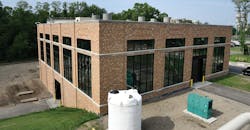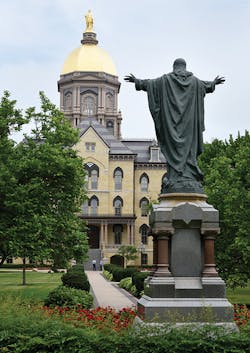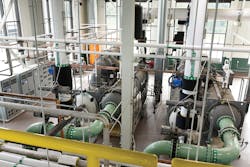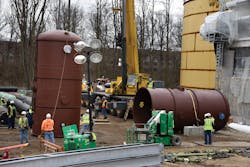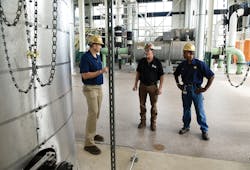At a time when the trend is to move away from large district heating and cooling systems, The University of Notre Dame is doubling down on their investment in centralized systems.
Founded in 1842 and located just south of the Indiana/Michigan border, Notre Dame’s illustrious reputation is matched only by the impact its campus leaves on visitors. Of the 170+ buildings on the 1,260-acre property, the Basilica of the Sacred Heart is likely the most photographed. It’s a 230 foot tall cathedral reminding visitors of the university’s Catholic founding principles.
School managers take pride in its meticulously-groomed quads and imposing stone buildings. But below the lawn and on remote corners of campus lie the components of another source of pride, one that few people know of: a massive district heating and cooling system.
A decade ago, managers of Notre Dame’s Facilities Design and Operations embarked on a marathon journey to shrink the university’s carbon footprint. In place at the time, and still in use today, was a central steam plant used for heating, cooling and power generation. Though vastly upgraded and expanded, the university has had a steam plant in operation since the late 1800s, and has used steam for co-generation (production of electricity) since the 1950s.
Massive co-generation
The university’s current power plant features two combustion turbines and eight boilers fueled by natural gas. The steam boilers have capacities between 70 and 180 KPPH. These operate at 400 PSI, powering turbine generators and steam-driven chillers. In round numbers, the campus uses 20+ MW of power daily. About half of the university’s electric is sourced from onsite steam generation, while the rest is purchased from the local utility.
The five existing steam-driven chillers and two,new electric chillers range from 1,750 to 4,000 tons, providing chilled water to a huge storage and distribution system. Two new, conventional 2,000-ton Carrier chillers also supplement the system. These operate at night, capitalizing on reduced energy cost through the off-peak hours. Most of the buildings on campus are connected to this system.
“The volume of the chilled water system is about five million gallons, maintained between 39°F and 45°F,” explained Daniel Shoop, mechanical engineer and Notre Dame Utilities Department project manager. “The underground distribution is comprised of pipe up to 36 inches. We’ve calculated that the piping system alone contains three million gallons. There is also a newly-constructed, two-million-gallon chilled water storage tank, which is connected to the chilled water system by large plate and frame heat exchangers. In addition to the steam and conventional chillers, the giant chilled water loop is supplemented by new geothermal systems.”
The byproduct of the power production is low pressure steam between 10 and 70 PSI. This steam is further utilized as a heat source across campus, whether for space heat or domestic hot water production. Several of the buildings on campus have remote heating systems, but the district steam system supplies over 87 percent of the heating need.
In effect, the entire boiler system operates as a massive tri-gen system (combined heat, power and cooling generation).
“We have nine miles of steam utility tunnels distributing the low-pressure steam throughout the campus, for heating and localized DHW reheat,” said Shoop.
Shoop has been with Notre Dame for a decade, and has overseen most of the mechanical system upgrades since the decision was made to reduce energy consumption and the campus’s carbon footprint.
Four of the eight steam boilers have fuel oil backup capability.
Ground source supplementation
To offset the heating and cooling load on the centralized steam system, large geothermal systems have been added over the past four years, keeping pace with campus expansion. Coupled with massive thermal storage capacity, the ground source systems are serving smaller district systems comprised of several new buildings, as well as supplementing the main cooling loop that serves nearly the entire campus.
“There are three new geothermal systems here,” said Shoop. “We call them the ‘East Quad,’ at 300 tons of capacity, the ‘East Quad system,’ at 1,350 tons, and the ‘South Campus systems’, at 1,000 tons,” explained Shoop.
Each of the geothermal systems operates in the same manner: in heating mode, hot water produced by the heat pumps is stored in large, insulated vessels made by Niles Steel Tank (NST). This water is used to pre-heat makeup air to the buildings they serve, whether that be residence halls or laboratories. The labs especially have extremely high makeup air requirements due to the use of fume hoods, etc.
In cooling mode, the ground-source systems provide extra cooling capacity to the main campus cooling loop.
Mechanical systems at a glance
“Equipment in three new mechanical rooms supplement chilled water to the main cooling loop,” said Shoop. “They exist to reduce the load on the central heating and cooling systems by preheating make-up air for the buildings nearest them. The need to supply makeup air and the manner in which geothermal systems work seem to be an odd combination, until you consider the amount of thermal storage we have here.”
Fresh air requirements change dramatically throughout the day, especially in the laboratories. Ground-source heat pumps, on the other hand, excel at providing a steady source of heating or cooling. This dichotomy is overcome by providing ample thermal storage.
On the cooling side, the two new chillers provide chilled water to the nearby two million gallon above-ground tank via heat exchangers. Buildings all across campus then draw chilled water as needed for air conditioning during peak periods.
In heating mode, the ground-source capacity provided by the heat pumps use a regional piping system dedicated to the new buildings closest to the geothermal systems. In the East Quad system three ClimaCool heat pumps are installed. The East Campus system utilizes half-a-dozen York units, while
the South Campus is equipped with five large Trane heat pumps.
To flywheel the large geo systems through the volatile heating loads throughout the day, the two largest geothermal systems feature super-insulated Niles Steel Tank hot water buffer tanks.
To preserve precious floor space within the East plant building, two, 9,000-gallon vertical tanks are used. The South Campus system is located in the basement of the newly-built Walsh Family Hall, with limited ceiling height. Here, two, 9,000-gallon horizontal NST vessels were used. The units were installed before the walls were erected.
“We use Niles Steel tanks routinely,” said Matt Meert, project manager at Ideal Consolidated, Inc. “They’re currently building us a custom pressure vessel for a different project. For that job, just like at Notre Dame, it was critical to have a tank built to our exact specifications.”
All four of the large NST tanks were insulated and wrapped in aluminum by a subcontractor after being installed. A fifth, much smaller tank remains uninsulated and is used for compressed control air.
“We offer factory-installed insulation for buffer tanks,” said Alan Hopper, director of technical and support services at Niles Steel Tank. “But on jobs like this one, where the units will be transported on their side or craned into position, insulation is typically left for field installation.”
Large scale mechanical
Ideal Consolidated, a 70-year-old union mechanical firm in South Bend, was involved with the East plant construction which brings together a new cooling tower, the new chillers, and the massive chilled water storage, in addition to the largest geothermal field and hot water storage.
“I’ve been involved with the East Plant project for three years now,” said Ron Woods, general foreman at Ideal Consolidated. “Our biggest challenges simply revolved around the size of equipment used. With that said, it was a great experience for our apprentices.”
Fifteen hundred feet of 36-inch chilled water pipe was installed to connect the new plant to the existing campus chilled water system. At one point, there were 40 pipefitters onsite. Between the work with stainless steel and carbon steel pipes both indoors and out, Woods documented approximately 1,500 position welds over the course of the project. Andy J. Egan, a fabrication subcontractor, completed just as many off-site. It required 28 semi-truck loads to deliver all the fab work to the site. It required 28 semi-truck loads to deliver all the fab work to the site.
“When dealing with technical rigging of this size, even the smallest mistake can be lethal,” continued Woods. “I’m proud of the fact that we didn’t have a single reportable incident. We had more than 60 high-hazard lift plans throughout the project. There’s no question that this was one of the most substantial projects in the South Bend area in a long time.”
According to Meert, Ideal Consolidated also comppleted a chilled water pumping station that included four, 500 HP pumps capable to 7,000 GPM each, which serves to increase the pumping efficiency of the main cooling loop.
The heating side of the east plant project had its own large-scale considerations. The two vertical Niles Steel Tanks, at 9,000 gallons each, could not be transported across the floor of the mechanical building due to their weight. Instead, they were craned into position and set onto slabs supported by extra steel dunnage.
Installing the tanks took more effort than transporting them to the site. Niles Michigan, where the vessels were manufactured, is only 10 miles from Notre Dame. The most recent heating and cooling plant expansion wasn’t the first time the university has sourced water storage locally.
“I recently came across a reference to a Niles Steel Tank purchased in 1952,” said Shoop. “I doubt that it was the first one. When we can shop locally, we do.”
Moving forward
“The timeline on this job was tight, and it included bigger equipment than we’ve handled in a long time,” said Meert, who has been with Ideal Consolidated for over 25 years. “But we had support from the university, manufacturers and from the union.”
The university has eliminated its use of coal. Green technologies are being employed at a sweltering pace. New systems being installed, from ground loops to thermal storage, convey a sense of longevity.
All of the new technology is also, by design, expandable; it’s a deliberate trajectory. Even the piping to and from the two-million-gallon chilled water tank received an extra set of 36-inch tees with the intention of adding a second massive tank in the decades to come.
It’s clear that while Notre Dame aims to make an impact on the nation, the lives of its students, and visitors to campus, the impact it makes on the environment will only be reduced as the campus continues to grow.
